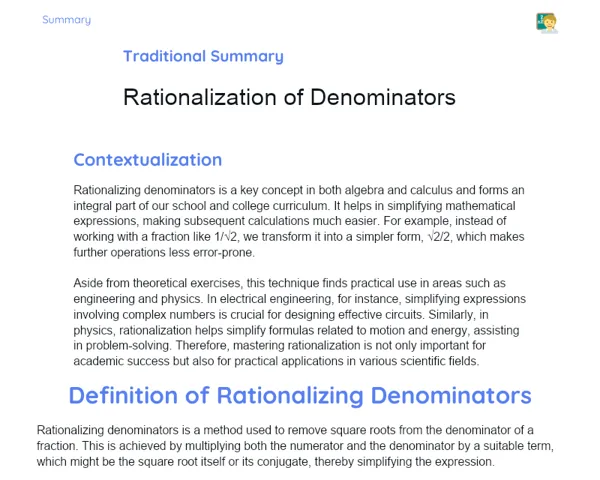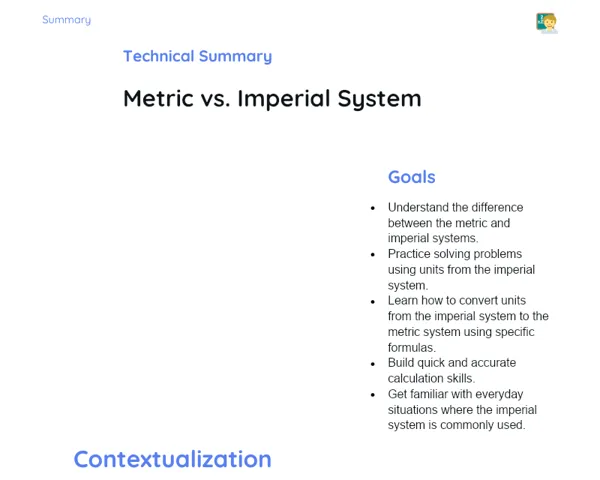Summary Tradisional | Polynomials: Roots
Contextualization
In mathematics, polynomials are algebraic expressions that hold a central place in many areas of both pure and applied sciences. We encounter polynomials in everyday scenarios too – whether it is in modeling natural phenomena, designing computational algorithms, or even forecasting economic trends. Having a good understanding of polynomials is essential for solving complex problems and carrying out detailed analyses in various scientific and technological disciplines.
One of the most important skills when working with polynomials is finding their roots. Roots are the values that make the entire polynomial equal to zero. Knowing how to determine these roots is valuable not only in theory but in practical applications as well. For instance, in engineering, determining the roots is a key step in designing sophisticated control systems used in industries like aerospace and automotive sectors. Similarly, in physics, roots help in predicting planetary orbits. Thus, a careful study of polynomial roots lays a strong foundation for further exploration in many fields.
To Remember!
Definition of Roots of a Polynomial
Roots of a polynomial are simply the values of x which make the polynomial zero. In mathematical language, if P(x) represents a polynomial, then its roots are the values of x for which P(x) = 0. This straightforward concept is very important as it is the starting point for solving many algebraic equations and related mathematical problems.
Take, for example, the polynomial P(x) = x^2 - 5x + 6. Here, the roots are the values satisfied by x in the equation x^2 - 5x + 6 = 0. Through factoring, we get (x - 2)(x - 3) = 0 which tells us that x = 2 and x = 3 are the roots.
The idea of roots is widely used, whether we are tackling simple equations or more complicated ones. This principle finds practical application too – be it solving motion problems in physics or designing control systems in engineering.
-
Roots are those values of x that make the polynomial zero.
-
They satisfy the equation P(x) = 0.
-
They are essential for solving algebraic equations and other math problems.
Factoring Polynomials
Factoring polynomials is a handy technique to find their roots by expressing the polynomial as a product of its smaller factors. For example, the quadratic polynomial P(x) = x^2 - 5x + 6 factors neatly as (x - 2)(x - 3).
When factoring, we break the polynomial down into components which, when multiplied, give us back the original expression. Each factor corresponds to a root of the polynomial. In the case mentioned above, the factors (x - 2) and (x - 3) reveal that the roots are x = 2 and x = 3.
This method works for polynomials of any degree, though naturally, the process becomes more challenging with higher degrees. Often, the process of grouping like terms or applying known algebraic identities can make factoring easier.
-
Factoring expresses the polynomial as product of smaller factors.
-
Each factor points directly to one of the roots.
-
It is possible for any degree of polynomial, with complexity increasing as degree increases.
Bhaskara's Method
Bhaskara's method refers to the well-known formula for finding the roots of quadratic polynomials of the form ax^2 + bx + c = 0. The formula is x = (-b ± √(b^2 - 4ac)) / (2a), derived by the method of completing the square. It gives a direct way to obtain the roots of any quadratic equation.
To use Bhaskara's method, we first identify the coefficients a, b, and c from the equation. The next step involves calculating the discriminant, Δ = b^2 - 4ac. The value of Δ tells us about the nature of the roots: if Δ > 0, there are two distinct real roots; if Δ equals 0, there is one repeated real root; and if Δ < 0, the roots are two complex conjugates.
The beauty of Bhaskara's formula lies in its simplicity and effectiveness, which makes it a favourite tool among students for quickly solving quadratic equations and understanding their properties.
-
It is a specific formula used for quadratic polynomials.
-
The method is founded on the technique of completing the square.
-
The discriminant (Δ) indicates the nature of the roots.
Multiple Roots
Multiple roots occur when a polynomial has the same root repeated more than once. The number of times a particular root appears as a factor of the polynomial is called its multiplicity. For example, in the polynomial P(x) = (x - 2)^2, the root x = 2 appears twice, indicating a multiplicity of 2.
Recognising multiple roots is important as they signal points where the graph of the polynomial either touches or just skims the x-axis. When a root has an even multiplicity, the graph tends to only touch or be tangent to the x-axis, whereas with odd multiplicity, the graph actually crosses it.
Moreover, multiple roots have implications for the derivative of the polynomial as well: the derivative will also have that root, but with a reduced multiplicity. A clear understanding of multiple roots thus enhances our overall analysis of how polynomials behave.
-
Multiple roots are repeating roots.
-
Their occurrence is indicated by how often the same root appears (its multiplicity).
-
They affect the nature of the polynomial’s graph as well as its derivative.
Key Terms
-
Polynomial: An algebraic expression made up of terms; each term is composed of a coefficient and a variable raised to a non-negative integer power.
-
Roots: The values of x that make the polynomial equal to zero.
-
Factoring: The process of rewriting a polynomial as a product of smaller, more manageable factors.
-
Bhaskara's Method: A formula derived for finding the roots of quadratic polynomials.
-
Discriminant: The quantity (Δ = b^2 - 4ac) that helps in determining the type of roots in a quadratic equation.
-
Multiple Roots: When a particular root appears more than once in a polynomial.
-
Fundamental Theorem of Algebra: It asserts that every polynomial of degree n has exactly n roots (taking multiplicities into account) in the complex number system.
Important Conclusions
In today’s lesson, we took a comprehensive look at the concept of polynomial roots, understanding that these are the specific values of x at which the polynomial becomes zero. We also discussed how factoring serves as a useful technique to find these roots, as well as how Bhaskara’s method efficiently solves quadratic equations. Moreover, grasping the idea of multiple roots and their effect on the polynomial graph adds another layer to our overall understanding.
The study of polynomial roots is not only fundamental in theoretical mathematics but also holds significant practical implications in engineering, physics, economics, and other fields. For example, in engineering, precise calculations of polynomial roots are crucial for control systems, while in physics, they assist in predicting planetary movements. We also introduced the Fundamental Theorem of Algebra, which reassures us that every polynomial will have exactly as many roots (when counted with their multiplicity) as its degree.
We encourage you to keep practising these concepts. Regular practice with different polynomial problems will strengthen your understanding, and you will soon feel confident tackling even the more challenging questions.
Study Tips
-
Regularly practice factoring various polynomials to get a feel for the process and spot common patterns.
-
Try solving different quadratic equations using Bhaskara's method to better understand and interpret the discriminant.
-
Relate these techniques to real-life problems in physics or engineering to see their practical importance.



